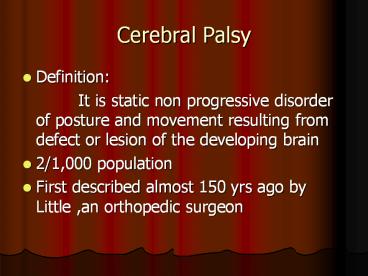Cerebral Palsy - PowerPoint PPT Presentation
Title:
Cerebral Palsy
Description:
Cerebral Palsy Definition: It is static non progressive disorder of posture and movement resulting from defect or lesion of the developing brain – PowerPoint PPT presentation
Number of Views:2291
Avg rating:3.0/5.0
Title: Cerebral Palsy
1
Cerebral Palsy
- Definition
- It is static non progressive disorder
of posture and movement resulting from defect or
lesion of the developing brain - 2/1,000 population
- First described almost 150 yrs ago by Little ,an
orthopedic surgeon
2
Association of CP
- Association of CP-
- MR
Epilepsy-25-35 - Speech defect 50 Deafness-10
- Visual defect-20 Dental problem
- Behavioral disorder 40
- Orthopedic problem Drooling
3
Classification
- Physiologic
- Spastic (65) Athetoid (30)
- Rigidity Ataxia
- Tremor Atonic/hypotonic
- Mixed unclassified
4
Anatomical classification
- Monoplegia Paraplegia
- Hemiplegia Triplegia
- Quadriplegia Diplegia
- Double hemiplegia
5
Etiological classification
- Prenatal
- Congenital anomalies
- Maternal
- Torch infection,Chorioamnionitis,
- Maternal sepsis, UTI
- Temperature during labor
- Toxemias of pregnancy
6
Perinatal Causes
- Birth trauma
- Perinatal asphyxia lt10
- LBW babies (prematurity IUGR)-due to
intracerebral hge, periventricular leukomalacia
7
Postnatal causes
- Infections-Meningitis, Encephalitis
- Trauma- Head injury, Subdural hemotoma
- Toxic kernicterus
- Cerebrovascular -thrombosis of C.vessels
- Endocrine and metabolic- hypothyroidism,
hypoglycemia, hypocalcemia, dyselectrolyte - Gross PEM in early infancy
8
Functional classification
- Class I- No limitation of activity
- Class II- Slight to moderate limitation (20)
- Class III- Moderate to great limitation(50)
- Class IV No useful physical activity (30)
9
Clinical manifestations
- Common presentation
- Delayed milestones with indifferent look
- Fisting of hands with extended extremities
- Microcephaly, Mental retardation
- Behavioral abnormalities
- Visual, hearing, speech defects
10
Common Presentations
- persistence of NN reflexes ,
- Exaggerated jerks
- Adductor spasms
- gait tip toe
- Epilepsy
11
Spastic hemiplegia
- Arms often more involved than leg-difficulty in
hand manipulation is obvious by 1 yr - Delayed walking -18-24 mo
- Equinovarus deformity of foot, walks on tip toes
because of increased tone - Affected upper limbs has dystonic posture when
child runs
12
Spastic hemiplegia
- Deep tendon reflexes increased, ankle clonus,
babinski sign - 1/3rd have seizure disorder
- 25 have MR
- CT/MRI- atrophic cerebral hemisphere with dilated
lateral ventriclecontralateral to the affected
side
13
Spastic Diplegia
- Bilateral spasticity of legs
- 1st noticed when infant begins to crawl-tends to
drag the legs behind more ( commando crawl) - Severe spasticity application of diaper is
difficult due to excess adduction of hips - Brisk reflexes, ankle clonus
- Scissoring posture of lower extremity when
suspended by axilla
14
Spastic Diplegia
- Walking tiptoes, disuse atropy ,impaired growth
of lower extremity - Intellectual development normal
- Minimal seizures
- CT/MRI-periventricular leukomalacia of white
matter mainly lower limb fibres
15
Spastic quadriplegia
- Most severe form ,most common
- All extremities severely impaired
- High association with MR and seizure
- Supranuclear bulbar palsies--aspiration
pneumonia - Flexion Contractures of knees and elbows
- Spastic quadriplegia athetosis mixed CP
16
Athetoid CP
- Relatively rare these days due to aggressive
management of hyperbilirubinemia - H/o NNJ hypermyelination of basal ganglia
called status marmoratus - Initially hypotonic, poor head control,marked
head lag,feeding difficulty,drooling
17
Athetoid CP
- After age 1yr athetoid movements become evident
- Speech is affected (slurred, voice modulation
impaired) due to involvement of oropharyngeal
muscles - Upper motor neuron signs not present
- Seizure uncommon
- Intellect -preserved
18
Rigidity/Ataxia/Tremor
- Uncommon variety
- Features og extrapyramidal lesion
- Lead pipe or cogwheel type
- Always associated with MR
- Ataxia
- Mostly congenital due to cerebellar malformation
- Tremor- constant severe coarse tremor
19
Diagnosis
- History
- Examination
- Serology-TORCH/VDRL
- X-ray skull-intracranial calcification
- EEG
- Ct/MRI
- Test of hearing ,vision
- IQ test
20
Treatment
- Multidisciplinary approach pediatrician playing
the main role - Physiotherapist Orthopedic surgeon
- Speech therapist ENT surgeon
- Neurologist Social worker
- Developmental psychologist
21
Treatment
- Counselling-teach parents-daily activities like
feeding, carrying, dressing, bathing, playing,
physiotherapy to limit abnormal muscle tone - Physiotherapy -
- For arms-physio to start by age 6 months
- For legs-for effective weight bearing and wt
transfer
22
Treatment
- Grasping ,release movements of hands, reciprocal
movements of feet for walking, vocalised
breathing for speech, parallel walking bars
bicycles, special chair, grasping and releasing
games - Massage, exercise and hydrotherapy
23
Treatment
- Adaptive equipments-walkers, poles standing
frames, motorized wheel chair, special feeding
devices, modified typewriters - Communication skills- use of symbols, specially
adapted computers
24
Treatment
- Ophthalmologist-strbismus, nystagmus, optic
atrophy - Orthopedics -
- Hip, knee contractures-surgical release
- Occupational therapy-
- Simple movements for self help- feeding,
dressing
25
Treatment
- Educational therapy
- Mild MR ordinary school
- Severe MR, severe disabilities-special school
- Social therapy-
- social and emotional support to family
- Rehabilitation and vocational guidance
26
Treatment
- Symptomatic-
- anticonvulsants for seizures
- Muscle relaxants- benzodiazapines ,dantrolene
sodium, Baclofen - Preventable causes shoud be prevented
27
Prognosis
- 10-50-have seizure
- Squint-50,visual handicap-30 optic atrophy and
cortical blindness - Walk by age of three, if not then unlikely that
useful function will be gained
28
(No Transcript)































